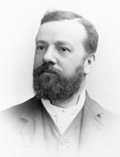Charles Batchelor

Charles W. Batchelor (December 25, 1845 – January 1, 1910) was an inventor and close associate of American inventor Thomas Alva Edison during much of Edison’s career. He was involved in some of the greatest inventions and technological developments in history.
Biographical Information
Charles Batchelor was born on Christmas Day, 1845, and raised in Manchester, England. He was draftsman and mechanist and later on, in his life he was Thomas Alva Edison's friend and right-hand man. [1] In 1870, while working for a textile equipment manufacturer, he was sent to the United States to install some equipment in a Newark, New Jersey textile factory. At this time Thomas Edison’s main laboratory and shop were also located in Newark where the two met. By the end of October 1871 Batchelor was working at Edison's American Telegraph Works and by the summer of 1873 was assisting Edison in inventing.
Charles Batchelor became one of Edison's closest laboratory assistants and business partners during the 1870s and 1880s. He assisted Edison with some of his most important projects in the fields of telegraphy, telephony, the phonograph, and electric lighting.
As a gifted experimenter, he was Edison's "hands," testing, tinkering with, and improving the models and apparatus built for Edison by John Kruesi. In 1873, Edison named his friend "Batch" as "chief experimental assistant". Together Batchelor and Edison would come up with prospective products.
Edison also frequently entrusted him with responsibility for special projects. In 1879, he went to London to supervise technical operations of the Edison Telephone Company of Great Britain, but he became ill there and returned to Menlo Park. Two years later Batchelor, installed a model of an electrical lighting station for the Paris Electrical Exposition of 1881. Batchelor stayed in Paris for the next three years as manager of the Edison electric light companies that were established there.
It was Edison’s practice to give his key assistants shares in his companies and to let them invest in the business ventures that resulted from their inventive activity. Along with other Edison assistants such as Samuel Insull, John Kruesi, Francis Upton, and Edward H. Johnson, Batchelor was an investor in Edison manufacturing enterprises, beginning with the Edison Electric Light Company (1878), and continuing with the Edison Lamp Company (1880), the Edison Machine Works (1881), which Batchelor managed between 1884 through 1888, and the Edison General Electric Company (1888). It was through their positions as both investors and employees of these concerns, that Edison and his men derived much of their income.
Charles Batchelor is also credited with introducing the young Nikola Tesla to Thomas Edison. In 1884, he wrote an introduction letter to Edison stating: “I know two great men, one is you and the other is this young man.” [2]
In 1887, when Edison relocated his experimental laboratory to West Orange, New Jersey, Batchelor supervised the construction of the buildings and later became "Treasurer and General Manager of the General Electric Company" (which succeeded the Edison General Electric Company in 1892). The General Electric Company grew to become one of the largest Fortune 500 companies in the United States.
Following his retirement from General Electric, Batchelor returned in 1899 to assist Edison with his ill-fated ore milling project. After the failure of the ore-refining business (in which he was a large investor), Batchelor left Edison’s employ to pursue work elsewhere. Their working relationship lasted thirty years. He traveled with his wife Rosanna and their daughters, worked selling securities, and eventually became president of Taylor Foundry Company.
At the time of his death on New Year's Day 1910 Batchelor was President of the Taylor Foundry Company.
External articles
- "Charles Batchelor". IEEE Global History Network. New York, NY, USA: Institute of Electrical and Electronics Engineers. Retrieved December 22, 2012.
- Dr. Ljubo Vujovic (July 10, 1998). "Tesla's Biography". Ridgewood, NY, USA: Tesla Memorial Society of New York. Retrieved December 22, 2012.
Biographies
- "Charles Batchelor: Edison's chief partner" by Walter L. Welch, Syracuse: Syracuse University, 1972.
References
- ↑ Delano, Marfe Ferguson (2002). A Photobiography of Thomas Alva Edison: Inventing the Future. Washington, DC: National Geographic Society. p. 25.
- ↑ Vujovic, 1998